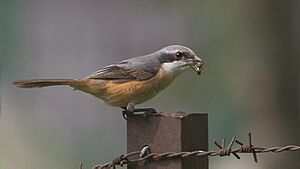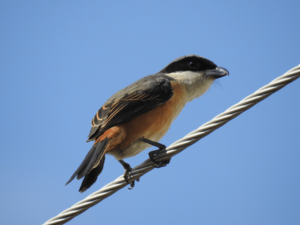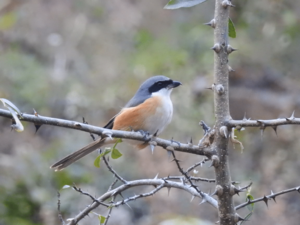Grey-backed shrike facts for kids
Quick facts for kids Grey-backed shrike |
|
|---|---|
 |
|
| Lanius tephronotus tephronotus from Khangchendzonga Biosphere Reserve, West Sikkim, India | |
| Conservation status | |
| Scientific classification | |
| Genus: |
Lanius
|
| Species: |
tephronotus
|
The grey-backed shrike (Lanius tephronotus) is a type of bird found in South-east Asia. It belongs to a group of birds called Laniidae, also known as shrikes. These birds are sometimes called "butcher birds" because of how they hunt.
Contents
About the Grey-backed Shrike
The grey-backed shrike was first described in 1831. This was done by a person named Nicholas Aylward Vigors. He found the bird near Darjeeling, India.
There are two main types, or subspecies, of the grey-backed shrike. These are L. t. lahulensis and L. t. tephronotus. They are very similar to another shrike, L. schach.
What Does it Look Like?
This bird is about 21 to 25 centimeters (8 to 10 inches) long. It weighs between 39 and 54 grams (about 1.4 to 1.9 ounces). It has a long tail.
The main type of grey-backed shrike has a black mask around its eyes. Its head and most of its back are dark grey. It has a small reddish-brown patch on its lower back. Its wings are black with pale edges. The tail is chestnut-brown. Its throat and belly are brownish-grey.
Both male and female birds look very much alike. Young birds are browner. Their eye mask is not as dark. They also have fine bars on their head and body.
What Does it Sound Like?
The grey-backed shrike makes a rough, breathing-like sound. Its call to protect its area sounds like "zzert-zzert..." or "tchert-tchert...". It also makes a repeated "ktcht-ktcht-ktcht" sound. This sound is often heard at dusk or when the bird is alarmed.
When breeding, their song is soft and musical. They can even copy the calls of other birds!
Where Does it Live?
The two subspecies of the grey-backed shrike live in different places.
- L. t. lahulensis breeds from northern Kashmir east to central India. It also lives in southwest China.
- L. t. tephronotus breeds from Nepal east to northeast India. It also lives in central and southern China.
When it's not breeding season, this bird flies south. It can be found in places like Bangladesh, Myanmar, Thailand, and Indochina.
Where Does it Like to Be?
These birds like to breed in high places. They live in forest clearings and mountain meadows. These areas have small trees or large bushes. They can be found as high as 4500 meters (about 14,700 feet) in Nepal and southern China.
After breeding, they might move to lower areas. They can be found in open forests or pastures. In lower areas, they live in farm valleys near people. During non-breeding times, they can be found in gardens and old farmlands.
Behavior and Life Cycle
Reproduction
Grey-backed shrikes build their nests between June and July in India. In southern China, they nest from April to August. They build their nests in bushes, usually 0.7 to 3 meters (2 to 10 feet) above the ground.
Their nests are big and look a bit messy on top. They are made of moss, straw, and grass. They sometimes use feathers from other birds, like the blue eared pheasant. Nests are often placed in a small tree or bush.
Females lay 3 to 6 eggs. The eggs are pale grey with lavender marks and brown spots. These spots often form a ring at the wider end of the egg. The female bird sits on the eggs for 15 to 18 days. She starts after the last egg is laid.
During this time, the female stays close to the nest. The male bird protects the nest. He makes a quick "ga.ga.ga..." call if other animals come near. Both parents take care of the baby birds for 14 to 15 days.
Birds that nest in high mountains have shorter breeding seasons. They lay fewer eggs. But their eggs are larger. This helps them survive in tough mountain conditions.
Food and Feeding
Grey-backed shrikes mostly eat insects. These include moths, crickets, grasshoppers, and beetles. They also eat caterpillars. Sometimes, they eat small vertebrates. These can be lizards, frogs, small birds, or tiny rodents.
These birds are "sit-and-wait" hunters. They often perch on top of tall grasses, bushes, or trees. From there, they look for prey moving below. Having good places to perch is important for them. They usually catch prey on the ground. But sometimes, they catch insects in the air.
During breeding season, they only hunt close to their nest. Like other shrikes, they like to stick their prey onto thorns or sharp branches. This is like having a "larder" or pantry for later meals.
Movements
Most grey-backed shrikes move to lower areas during winter. The subspecies lahulensis stays in the Himalayas or moves to the foothills. The other subspecies, tephronotus, either moves to lower altitudes or flies further south.
Non-breeding birds have been seen in the plains of southern China, India, Bangladesh, Myanmar, Thailand, Laos, and Vietnam. They usually return to their breeding areas by early May.
Grey-backed Shrikes and People
Grey-backed shrikes often choose to live near human settlements. This is because these places can offer good hunting spots. They also provide safe places from bigger predators.
This bird is quite common in many areas. There is no sign that it is in danger globally. However, their homes could be at risk if land is used differently. High-elevation homes are safer than those in lower areas.
Conservation Status
The grey-backed shrike lives across a very large area. It seems to be common in many places. The number of these birds appears to be stable. This means their population is not dropping quickly.
Because of this, the grey-backed shrike is listed as a Least Concern species. This means it is not currently considered to be at risk of disappearing.




